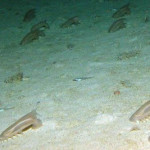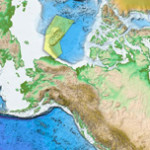 Two major expeditions took place in the last few months. The first explored Celebes Sea south of the Philippines from the surface to a depth 2700m.
Two major expeditions took place in the last few months. The first explored Celebes Sea south of the Philippines from the surface to a depth 2700m.
“This is probably the center where many of the species evolved and spread to other parts of the ocean, so it’s going back to the source in many ways,” Madin [the expedition leader] stated.
The project involved the Woods Hole Oceanographic Institution and National Geographic Magazine in cooperation with the Philippine government, which also provided the exploration ship.
The most striking creature found was a spiny orange-colored worm that had 10 tentacles like a squid, Madin said. “We don’t know what it is … it might be something new,” he said.

In the second expedition, researchers from Fisheries and Oceans Canada and Memorial University of Newfoundland conducted a survey of the deep off the coasts of Nova Scotia and Newfoundland during a three-week mission in July 2007. The focus was primarily deep-water corals.
The mission revealed that life in these waters is much more diverse than previously realized. Researchers captured over 3,000 high quality photographs that displayed this diversity, including an octopus with large fins near its eyes, known as “Dumbo,” a potentially new species of scallop, and a single-celled organism previously unknown in this region
. The photo album can be viewed here.

Picture Credits:
Top left: In this photo released by the Woods Hole Oceanographic Institution (WHOI) and the National Geographic Society-led Inner Space Speciation Project (ISSP) shows a sample of zooplankton collected with a Tucker Trawl with a 10mm opening wherein one can find jellyfish, a lanternfish, a snipe eel, two orange shrimp, a pyrosome (which is bioluminescent) as shown at a briefing Tuesday Oct. 16, 2007 aboard the Philippine research vessel BRP Prisbitero off Manila Bay in Manila, Philippines. A joint team of Filipino and American scientists that explored the Celebes Sea in southern Philippines early this month, announced the marine-life discoveries following their return from their voyage Tuesday. (AP Photo/WHOI/ISSP, Larry Madin HO)
Second Center: Colourful coral species on a vertical cliff in the Stone Fence. The ROPOS mission uncovered coral as old as 800 years.
Third Center: This Dumbo Octopus from the Sable Gully MPA received its name because of the large fins located on either side of its head.
Fourth Center: A Basket Star embedded in Bubblegum Coral.







amazing images… my indo-pacific program manager met with some of the expedition crew while passing through manila a few weeks ago… very cool that reports of findings are turning around so quickly… ocean science might actually soon give nasa a run for its money in pr for its missions… it’s this sort of public awareness of exciting near real-time science that sparks interest in youth (future scientists)…
>blockquote>
“This is probably the center where many of the species evolved and spread to other parts of the ocean, so it’s going back to the source in many ways,” Madin [the expedition leader] stated.
I’d like to hear their case for that.
The Indo-Pacific has long been hypothesized to be the center of origin for shallow marine fauna. Here is a link to several papers on the subject.
http://scholar.google.com/scholar?hl=en&lr=&safe=off&q=indo+pacific+center+of+origin&btnG=Search
In several conversations I’ve had over the few years with eminent barnacle biologist, Bill Newman from Scripps, we’ve talked about how the Indo-Pacific appears to be the center of diversity for deep sea barnacles. Newman et al. write in the Handbook of Deep-Sea Hydrothermal Vent Fauna
“The center of distribution, where representatives of most genera are presently found, is in the SW Pacific, specifically the Lau Basin, Tonga. It is noteworthy that centers of diversity at high taxonomic levels in numerous other relic groups of marine invertebrates are also found in the SW Pacific.[…] the center of distribution is where availability of the vent-seep habitat has been the least interrupted in space or time, for otherwise such a high taxonomic endemicity could not have accumulated. Like the high taxonomic endemicity of the SW Pacific in general, that of the vent barnacles appears to the result of reliction due to habitat restriction rather than to barriers to dispersal per se.”